Research on the Healing Effect Evaluation of Campus’ Small-Scale Courtyard Based on the Method of Semantic Differential and the Perceived Restorative Scale
Abstract
1. Introduction
1.1. Research on the Healing Effect of the Environment in Colleges
- The layout and spatial forms of different plants bring about different healing effects;
- The placement of activity spaces has an impact on the healing effect of the courtyard;
- The healing ability of the environment may be related to the manner of perception of the user: the healing effect brought about by direct visual feeling and that by indirect desire for activity may be different.
1.2. Researches on Environmental Healing Capability Evaluation
2. Materials and Methods
2.1. Study Area and Samples
2.2. Study Methods
2.2.1. SD Method
2.2.2. PRS
2.2.3. Experimental Design
2.2.4. Analytical Framework
3. Results
3.1. Reliability and Validity Analysis
3.2. Descriptive Statistics
3.3. Factorial Analysis
3.4. Renaming of Common Factors
3.5. Common Factor Scores Statistics
4. Discussion
4.1. Discussion Based on Initial Categories
4.1.1. “Ornamental”
4.1.2. “Uniqueness”
4.1.3. “Activity”
4.2. Discussions Based on Common Factors
4.2.1. “Perceived Quality”
4.2.2. “Experience Quality”
4.3. Conjectures
- According to the comparison between the eigenvalues of common factors in the Scree plot and the scores of the PRS, although the common factor scores of the three were similar, the PRS scores of Courtyard Ⅱ and Courtyard Ⅲ, with higher “Perceived Quality” scores, were much higher than those of Courtyard I, with similar “Experience Quality” scores. That is, it is speculated that the original items with higher “Perceived Quality” loading distribution, such as “plant colors and species”, “element richness”, and “plant coverage,” can improve the healing quality of small-scale campus courtyards more significantly than the spatial elements and characteristics described by the original items with higher “Experience Quality” loading (“sense of harmony,” “ground pavement feeling,” “activity space richness,” etc.).
- Courtyard Ⅲ, with its smaller activity space area, had higher “activity space richness” (4.94) and “resting facilities comfort” scores (5.02) than the other two sample courtyards with larger activity space areas. In the actual situation, the form of the activity space of Courtyard Ⅲ was more distinctive, and the function orientation of the activity space was unclear, so it was hypothesized that users have a higher demand and preference for activity spaces with ambiguous function and better senses of atmosphere.
- Among the scores for “ground pavement feeling”, the scores of the sample courtyards were Courtyard Ⅲ (5.08) > Courtyard Ⅰ (4.64) > Courtyard Ⅱ (4.37). The ground of Courtyard I was paved with stone collage; Courtyard II was paved with stone; and Courtyard III was paved with brick. The scores of “senses of harmony” were combined with the real circumstances of the sample courtyards. As a consequence, we speculated that moderately curved brick paving can obtain a higher score for tactile preference than flat stone collage paving or flat ordinary stone paving.
5. Conclusions
- Small-scale courtyards with more dense plants have higher healing abilities, and the type and layout of plants also affect the healing effect. Plants close to or higher than human visual height, such as trees or shrubs, have a better healing effect than lawns. An irregular layout of plants can also bring about a more beautiful aesthetic and better light than a monotonous layout, thus strongly diverting people’s attention from pressure.
- In small-scale courtyards, different forms of activity spaces correspond to different landscape preferences, but users’ preferences for activity spaces do not depend on the scale of the activity space.
- In terms of the perception mode of users, we used “Perceived quality” and “Experienced quality” to represent the healing qualities of the courtyard relative to abstract feelings or atmospheres that are difficult to distinguish directly. “Perceived quality” is related to the healing elements that can be perceived by vision or intuition, such as color, element richness, light and shadow effect, etc. “Experience quality” involves healing elements related to behavioral interaction or details, such as spatial form and coordination, etc. The presence of rich plant species or landscape sketches can enhance the visual impact of the environment, thus providing direct sensory satisfaction to users and improving the “perceived quality” of the courtyard landscape. On the other hand, tortuous roads and greater amounts of information in courtyards can make the environment more mysterious, thus stimulating users’ desire to explore and improving the “experience quality” of the courtyard landscape.
Author Contributions
Funding
Institutional Review Board Statement
Informed Consent Statement
Data Availability Statement
Acknowledgments
Conflicts of Interest
References
- Stichler, J.F. Creating healing environments in critical care units. Crit. Care Nurs. Q. 2001, 24, 1–20. [Google Scholar] [CrossRef] [PubMed]
- Kaplan, R.; Kaplan, S. Experience of Nature: A Psychological Perspective; Cambridge University Press: New York, NY, USA, 1989. [Google Scholar]
- Kaplan, S. The Restorative Benefits of Nature: Toward an Integrative Framework. J. Environ. Psychol. 1995, 15, 169–182. [Google Scholar] [CrossRef]
- Ulrich, R.S. Visual Landscapes and Psychological Well-Being. Landsc. Res. 1979, 4, 17–19. [Google Scholar] [CrossRef]
- Ulrich, R.S. View Through a Window May Influence Recovery from Surgery. Science 1984, 224, 420–421. [Google Scholar] [CrossRef]
- Dzhambov, A.M.; Hartig, T.; Tilov, B.; Atanasova, V.; Makakova, D.R.; Dimitrova, D.D. Residential greenspace is associated with mental health via intertwined capacity-building and capacity-restoring pathways. Environ. Res. 2019, 178, 108708. [Google Scholar] [CrossRef]
- Dzhambov, A.M.; Markevych, I.; Hartig, T.; Tilov, B.; Arabadzhiev, Z.; Stoyanov, D.; Gatseva, P.; Dimitrova, D.D. Multiple pathways link urban green- and bluespace to mental health in young adults. Environ. Res. 2018, 166, 223–233. [Google Scholar] [CrossRef]
- Ulrich, R.S.; Cordoza, M.; Gardiner, S.K.; Manulik, B.J.; Fitzpatrick, P.S.; Hazen, T.M.; Perkins, R.S. ICU Patient Family Stress Recovery During Breaks in a Hospital Garden and Indoor Environments. HERD Health Environ. Res. Des. J. 2020, 13, 83–102. [Google Scholar] [CrossRef]
- Wells, N.M. At Home with Nature: Effects of “Greenness” on Children’s Cognitive Functioning. Environ. Behav. 2000, 32, 775–795. [Google Scholar] [CrossRef]
- White, M.P.; Pahl, S.; Wheeler, B.W.; Depledge, M.H.; Fleming, L.E. Natural environments and subjective wellbeing: Different types of exposure are associated with different aspects of wellbeing. Health Place 2017, 45, 77–84. [Google Scholar] [CrossRef]
- Jiang, W.; Zou, M. Innovative design of campus green spaces in the context of the “One Belt, One Road” and the digital use of Silk Road elements. E3S Web Conf. 2021, 236, 05031. [Google Scholar] [CrossRef]
- Abu-Ghazzeh, T.M. Communicating Behavioral Research to Campus Design. Environ. Behav. 1999, 31, 764–804. [Google Scholar] [CrossRef]
- Zhu, Y. Student’s Living Space Study and Improved Design in Shenzhen University Town. Master’s Thesis, Harbin Institute of Technology, Harbin, China, 2016. (In Chinese). [Google Scholar]
- Zhang, M.; Ying, L. Evaluation on Green Space Use on University Campuses Based on PSPL Survey Method: A Case of the Youth Garden of Huazhong University of Science and Technology. Urban. Archit. 2022, 19, 175–178. (In Chinese) [Google Scholar] [CrossRef]
- Francis, C.; Marcus, C. Places people take their problems. In Proceedings of the 22nd Annual Conference of the Environmental Design Research Association; Urbina-Soria, J., Andeane, P.O., Bechtel, R., Eds.; Environmental Design Research Association: Oklahoma City, OK, USA, 1991; pp. 178–184. [Google Scholar]
- Foellmer, J.; Kistemann, T.; Anthonj, C. Academic Greenspace and Well-Being—Can Campus Landscape be Therapeutic? Evidence from a German University. Wellbeing Space Soc. 2020, 2, 100003. [Google Scholar] [CrossRef]
- Ying, J.; Jin, H.; Zhang, Y.; Shao, Z. The Pathway of the Role of Campus Green Space Contact Motivation on University Students’ Psychological Well-being—A Moderated Chain Mediation Model. Chin. Landsc. Archit. 1–6. Available online: http://kns.cnki.net/kcms/detail/11.2165.TU.20220720.1603.002.html (accessed on 1 April 2023). (In Chinese).
- Liu, Q.; Zhang, Y.; Lin, Y.; You, D.; Zhang, W.; Huang, Q.; van den Bosch, C.C.K.; Lan, S. The relationship between self-rated naturalness of university green space and students’ restoration and health. Urban For. Urban Green. 2018, 34, 259–268. [Google Scholar] [CrossRef]
- Wang, S.; Du, H. The Healing Effects of Skycourts in High-rise Office Buildings in the Pearl River Delta. South Archit. 2022, 7, 29–35. (In Chinese) [Google Scholar] [CrossRef]
- Yang, G. Research on the design of urban micro-healing space from the perspective of mental health. Xiandai Hortic. 2021, 44, 60–61. (In Chinese) [Google Scholar] [CrossRef]
- Chien, J.W.; Yang, Y.R.; Chen, S.Y.; Chang, Y.J.; Chan, C.C. Urban Open Space Is Associated with Better Renal Function of Adult Residents in New Taipei City. Int. J. Environ. Res. Public Health 2019, 16, 2436. [Google Scholar] [CrossRef]
- Luo, X.; Ge, J.; Chen, F.; Kazunori, H. Residential Environment Evaluation Model and Residential Preferences of the Changjiang Delta Region of China. J. Asian Archit. Build. Eng. 2007, 6, 299–306. [Google Scholar]
- Huang, J.; Ge, X. A Study of Built Environment Evaluation Based on Street View Images—Taking Green View Ratio and Green Land Ratio as Examples. J. Soc. Sci. Humanit. 2020, 2, 80–84. [Google Scholar]
- Zhu, L.; Meng, H.; Long, J. Elements and Research Framework Construction of “Human-Centered” Elements and Research Framework Construction of “Human-Centered” Healing Landscape in the Post-Pandemic Era. Urban Environ. Des. 2021, 374–381. (In Chinese) [Google Scholar] [CrossRef]
- Wan, J.; Zhao, Y.; Chen, Y.; Wang, Y.; Su, Y.; Song, X.; Zhang, S.; Zhang, C.; Zhu, W.; Yang, J. The Effects of Urban Neighborhood Environmental Evaluation and Health Service Facilities on Residents’ Self-Rated Physical and Mental Health: A Comparative and Empirical Survey. Int. J. Environ. Res. Public Health 2022, 19, 4501. [Google Scholar] [CrossRef] [PubMed]
- Liu, Q.; Chen, Y.; Zhang, W.; Zhang, Y.; Huang, Q.; Lan, S. Tourists’ environmental preferences, perceived restoration and perceived health at Fuzhou National Forest Park. Resour. Sci. 2018, 40, 381–391. (In Chinese) [Google Scholar] [CrossRef]
- Yang, Q.; Zhang, Y. Research on Landscape Quality Evaluation of a City Park Based on the SD Method—A Case Study of the Tanhua Temple Park in Kun-ming. Chongqing Archit. 2022, 21, 20–23, 26. (In Chinese) [Google Scholar]
- Wei, L.; Huang, Q. Spring Landscape Quality Evaluation of Six Urban Parks in Shanghai Based on SBE and SD Methods. Landsc. Archit. Acad. J. 2022, 39, 125–134. (In Chinese) [Google Scholar]
- Wang, X.; Wu, C.; Yan, J. Experimental Study of the Perceived Restorative Scale (PRS) in Chinese by Evaluating the Restorative Qualities of Urban Park Scenes. Chin. Landsc. Archit. 2019, 35, 45–48. (In Chinese) [Google Scholar]
- Xue, L. The Study on the Environmental Perception and Perceived Restorativeness of Tourists in Three Parks of Chengdu. Master’s Thesis, Sichuan Agricultural University, Ya’an, China, 2020. (In Chinese) [Google Scholar] [CrossRef]
- Wang, X.; Rodiek, S.; Wu, C.; Chen, Y.; Li, Y. Stress recovery and restorative effects of viewing different urban park scenes in Shanghai, China. Urban For. Urban Green. 2016, 15, 112–122. [Google Scholar] [CrossRef]
- Kreibig, S.D. Autonomic nervous system activity in emotion: A review. Biol. Psychol. 2010, 84, 394–421. [Google Scholar] [CrossRef]
- Darrow, C.W.; Gullickson, G.R. The peripheral mechanism of the galvanic skin response. Psychophysiology 1970, 6, 597–600. [Google Scholar] [CrossRef]
- Martin, I.; Venables, P.H. Mechanisms of palmar skin resistance and skin potential. Psychol. Bull. 1966, 65, 347. [Google Scholar] [CrossRef]
- Kaplan, S.; Kaplan, R. Cognition and Environment: Coping in an Uncertain World; Praeger: New York, NY, USA, 1982. [Google Scholar]
- Osgood, C.E. The Measurement of Meaning; Illinois Univ Press: Chicago, IL, USA, 1957. [Google Scholar]
- Laumann, K.; Gärling, T.; Stormark, K.M. Rating scale measures of restorative components of environments. J. Environ. Psychol. 2001, 21, 31–44. [Google Scholar] [CrossRef]
- Herzog, T.R.; Maguire, P.; Nebel, M.B. Assessing the restorative components of environments. J. Environ. Psychol. 2003, 23, 159–170. [Google Scholar] [CrossRef]
- Huang, C.-C.; Hwang, F.-M.; Chou, H.-C. The Relationships between Environmental Preference and Restorative Perception of Environment: A Case of Moutainscape. J. Outdoor Recreat. Study 2008, 21, 1–25. (In Chinese) [Google Scholar]
- Chen, R.; Han, B.; Lin, F.; Cui, Y.; Pan, H. Relationship between Environmental Quality and Perceived Restoration of Forest Parks. J. Chin. Urban For. 2021, 19, 85–89. [Google Scholar] [CrossRef]
- Huang, Y.; Fu, W.; Weng, Y.; Wagn, M. A Study on the Relationship between Individual Landscape Preference, Perceived Restorativeness Scale and Health Benefits Assessment of Urban Forest Pathway—A Case Study of Fudao. Chin. Landsc. Archit. 2020, 36, 73–78. (In Chinese) [Google Scholar] [CrossRef]
- Zhuang, W. SD Method and Evaluation of Architectural Space Environment. J. Tsinghua Univ. (Sci. Technol.) 1996, 4, 42–47. (In Chinese) [Google Scholar] [CrossRef]
- Cohen-Cline, H.; Turkheimer, E.; Duncan, G.E. Access to green space, physical activity and mental health: A twin study. J. Epidemiol. Community Health 2015, 69, 523–529. [Google Scholar] [CrossRef]
- Tsunetsugu, Y.; Park, B.J.; Miyazaki, Y. Trends in research related to “Shinrin-yoku” (taking in the forest atmosphere or forest bathing) in Japan. Environ. Health Prev. Med. 2010, 15, 27–37. [Google Scholar] [CrossRef]
- Xiao, Y.; Zhang, Y.; Lu, S.; Kuang, X. Exploring the Relationship Between Multi-Dimensional Residential Greening Perceived Neighborhoods Greenness Level and Residents’ Mental Health Based on Multi-source Data: A Case Study of Shanghai Lilong. Landsc. Archit. 2021, 28, 108–113. (In Chinese) [Google Scholar] [CrossRef]
- Morgan, W.P. Affective beneficence of vigorous physical activity. Med. Sci. Sport. Exerc. 1985, 17, 94–100. [Google Scholar] [CrossRef]
- North, T.C.; McCullagh, P.; Tran, Z.V. Effect of exercise on depression. Exerc. Sport Sci. Rev. 1990, 18, 379–416. [Google Scholar] [CrossRef] [PubMed]
- Bahrke, M.S.; Morgan, W.P. Anxiety reduction following exercise and meditation. Cogn. Ther. Res. 1978, 2, 323–333. [Google Scholar] [CrossRef]

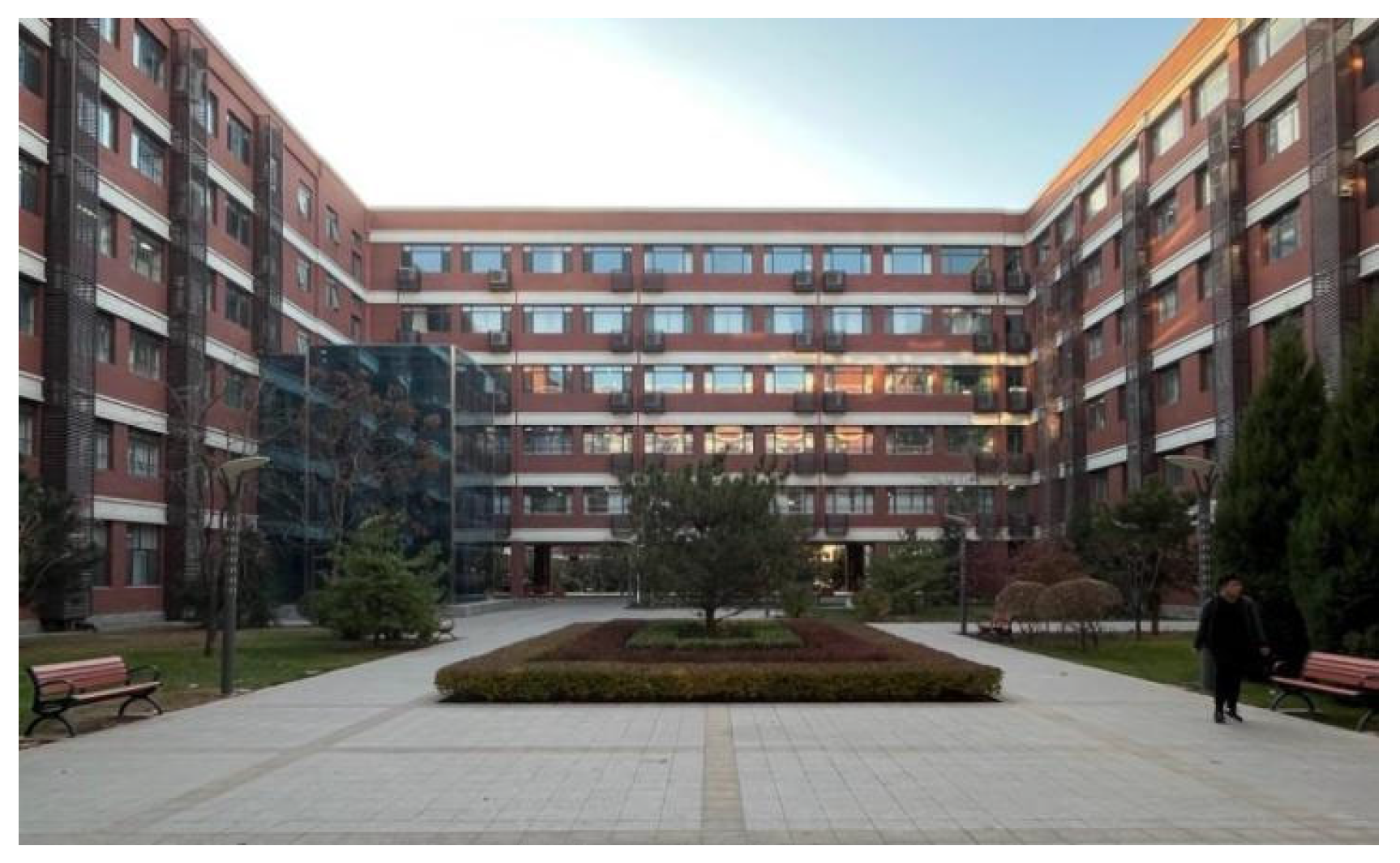


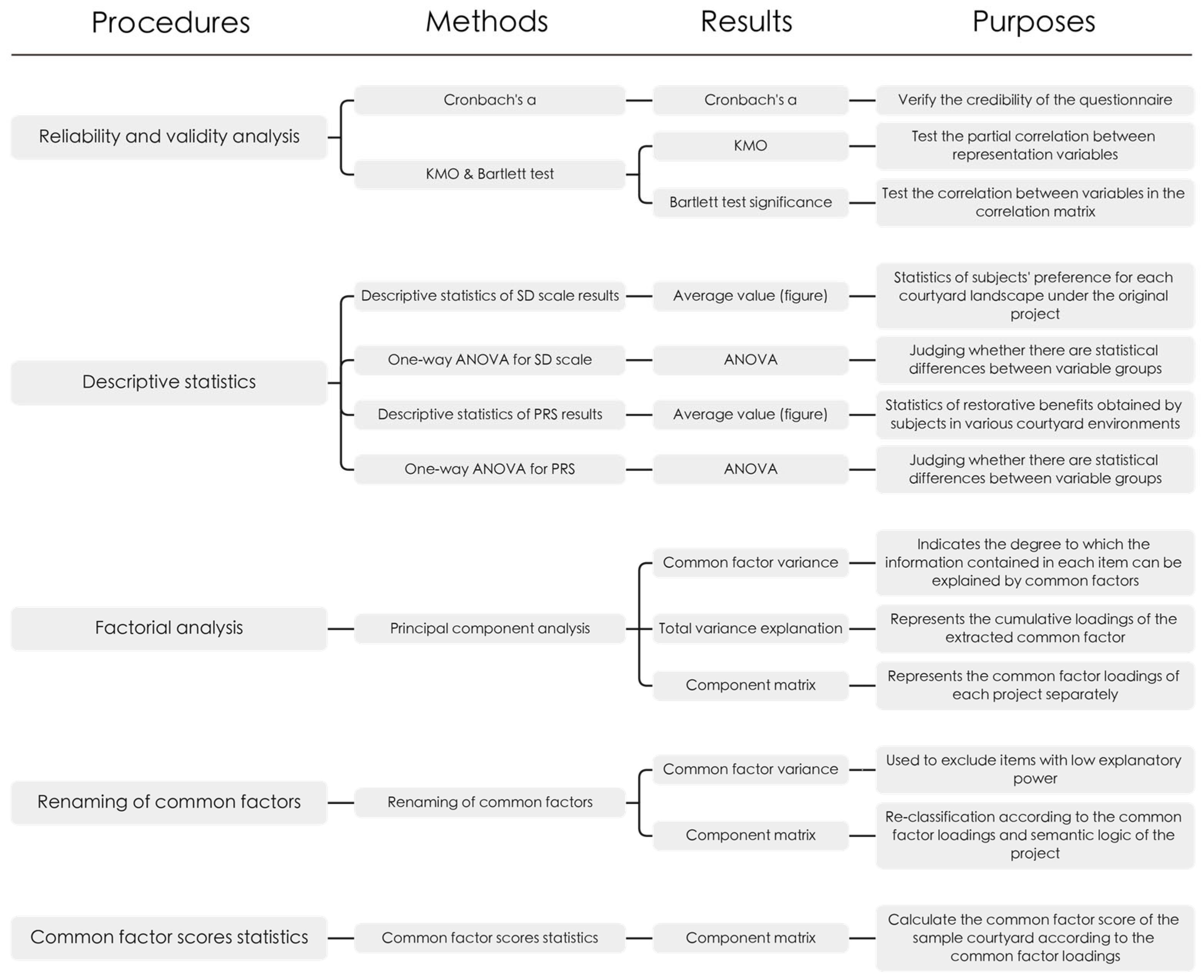
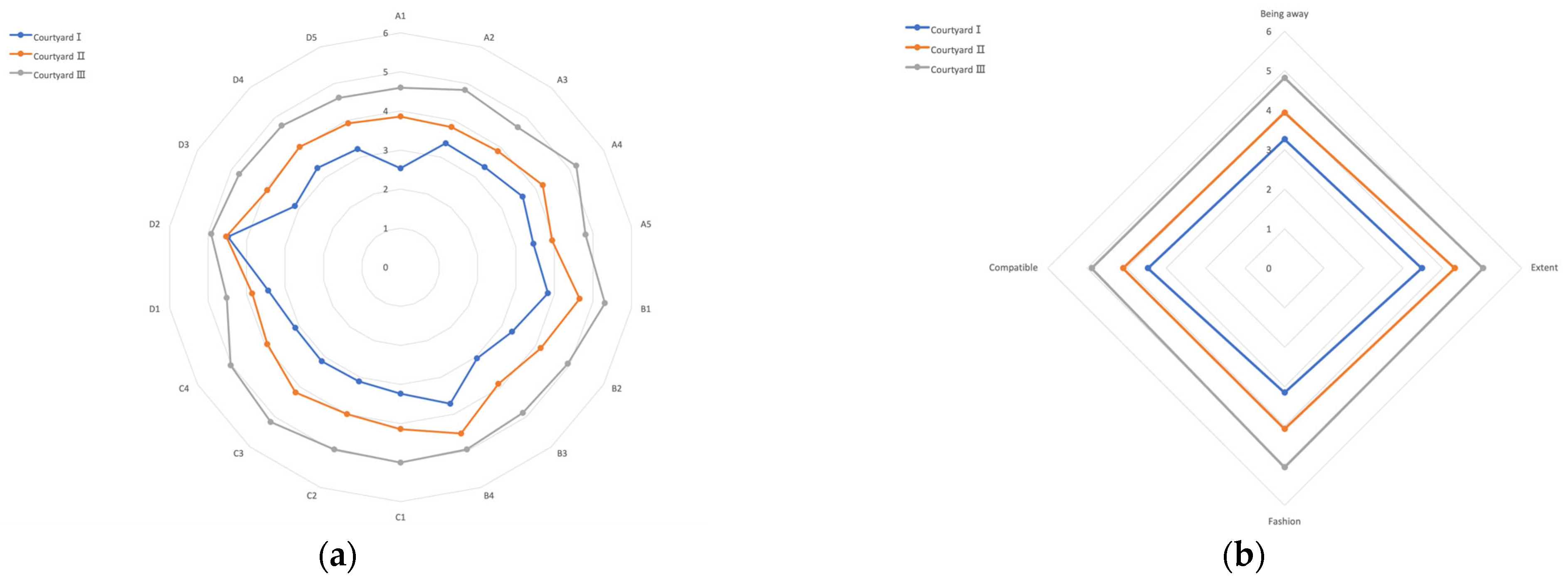
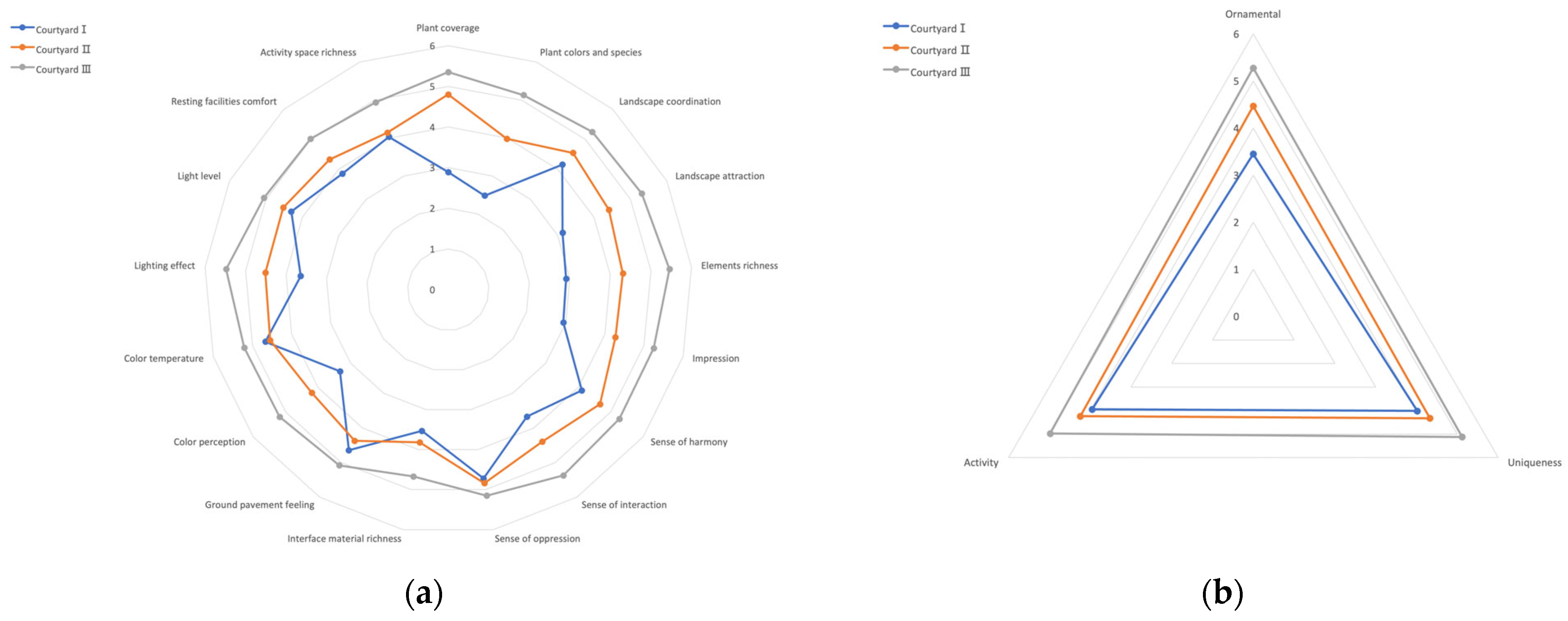
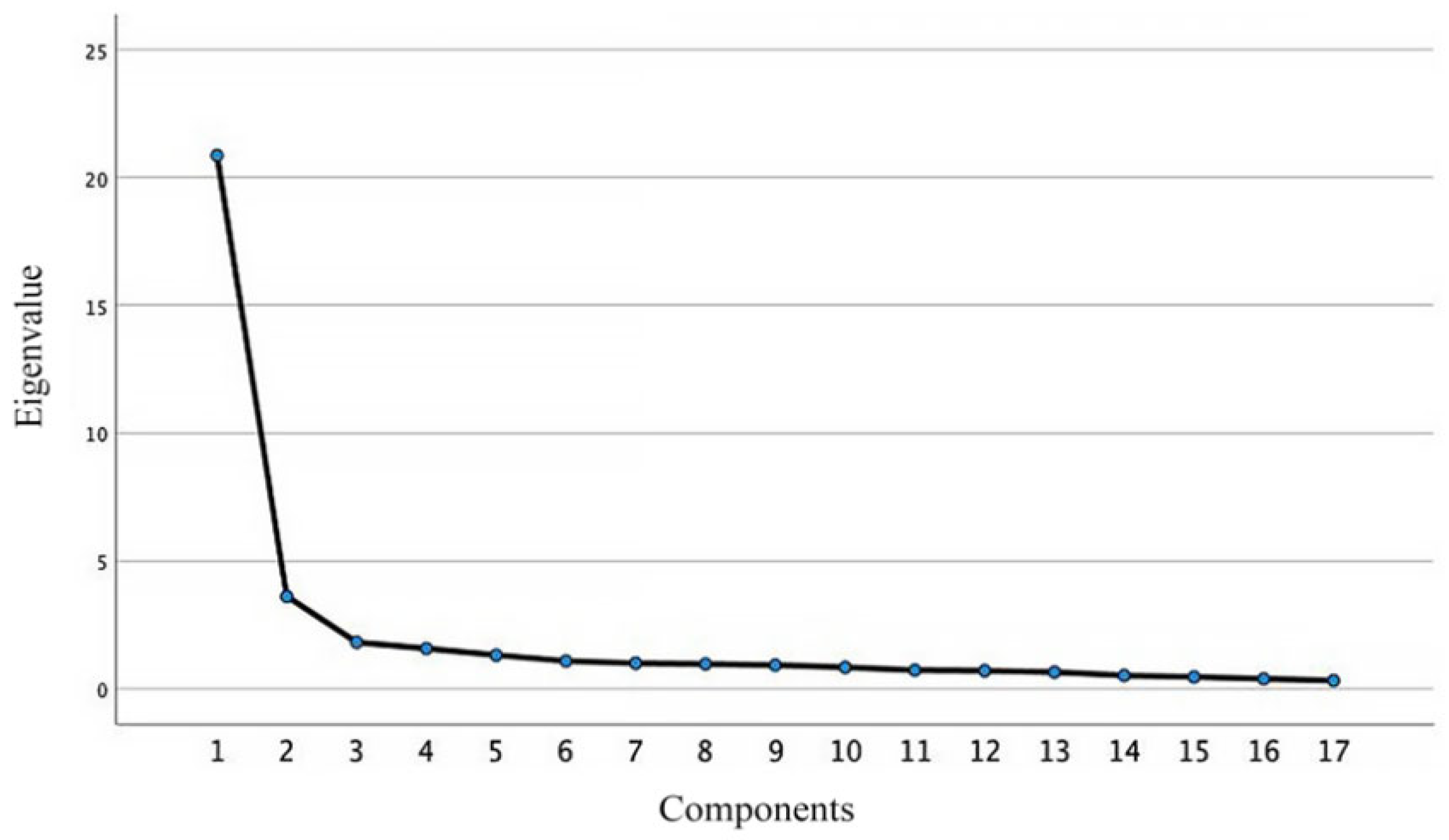



| Classification | Number | Items | Adjectives | |
|---|---|---|---|---|
| Ornamental (A) | Landscape image (A1) | 1 | Plant coverage | Barren/Lush |
| 2 | Plant colors and species | Poor/Abundant | ||
| 3 | Landscape coordination | Chaos/Harmonious | ||
| 4 | Landscape attraction | Unattractive/Attractive | ||
| 5 | Elements richness | Poor/Abundant | ||
| 6 | Impression | Forgettable/Memorable | ||
| 7 | Sense of harmony | Incompatible/Harmonious | ||
| Spatial organization (A2) | 8 | Sense of interaction | Isolated/Familiar | |
| 9 | Sense of oppression | Oppressive/Relaxed | ||
| Uniqueness (B) | Interface form (B1) | 10 | Interface material richness | Poor/Abundant |
| 11 | Ground pavement feeling | Sudden/Harmonious | ||
| 12 | Color perception | Same/Rich | ||
| 13 | Color temperature | Cold/Warm | ||
| Luminous environment (B2) | 14 | Lighting effect | Boring/Beautiful | |
| 15 | Light level | Dim/Bright | ||
| Activity (C) | Active factors (C1) | 16 | Resting facilities comfort | Uncomfortable/Comfortable |
| 17 | Activity space richness | Lack/Sufficient | ||
| Characteristics | Number | Items |
|---|---|---|
| Being away(A) | A1 | This can give me an experience that is out of the world. |
| A2 | This place gives me a break from the routine of my daily life. | |
| A3 | This is a place where I can rest completely. | |
| A4 | The environment here can help me relax my tense mood. | |
| A5 | I feel free from work and daily life here. | |
| Extent(B) | B1 | I think the surrounding scenery is harmonious. |
| B2 | I am quite curious about the invisible landscape. | |
| B3 | The landscape here can make me extend many beautiful associations. | |
| B4 | The elements of the landscape here are matched. | |
| Fashion(C) | C1 | The environment here has attractive characteristics. |
| C2 | The environment here can attract me to explore and discover more. | |
| C3 | The environment here is charming. | |
| C4 | I will want to spend more time in this environment. | |
| Compatibility(D) | D1 | I can do what I like here. |
| D2 | I can adapt to the environment here quickly. | |
| D3 | I feel that I have integrated with this environment. | |
| D4 | I can find a way to enjoy myself here. | |
| D5 | This place is very suitable for doing what I like. |
| Number | N | Average Value | Standard Deviation | Variance |
|---|---|---|---|---|
| 1 | 64 | 65.05 | 20.67 | 427.03 |
| 2 | 49 | 78.12 | 22.01 | 484.36 |
| 3 | 52 | 92.56 | 20.48 | 419.43 |
| Base line | - | 68.00 | - | - |
| Number | Items | Courtyard | Categories | Courtyard | ||||
|---|---|---|---|---|---|---|---|---|
| Ⅰ | Ⅱ | Ⅲ | Ⅰ | Ⅱ | Ⅲ | |||
| 1 | Plant coverage | 2.89 | 4.80 | 5.35 | Ornamental | 3.45 | 4.47 | 5.28 |
| 2 | Plant colors and species | 2.48 | 3.98 | 5.13 | ||||
| 3 | Landscape coordination | 4.16 | 4.55 | 5.25 | ||||
| 4 | Landscape attraction | 3.14 | 4.41 | 5.31 | ||||
| 5 | Element richness | 2.91 | 4.31 | 5.46 | ||||
| 6 | Impression | 2.94 | 4.27 | 5.25 | ||||
| 7 | Sense of harmony | 4.11 | 4.67 | 5.27 | ||||
| 8 | Sense of interaction | 3.67 | 4.39 | 5.37 | ||||
| 9 | Sense of oppression | 4.72 | 4.84 | 5.15 | ||||
| 10 | Interface material richness | 3.53 | 3.82 | 4.67 | Uniqueness | 4.02 | 4.33 | 5.12 |
| 11 | Ground pavement feeling | 4.64 | 4.37 | 5.08 | ||||
| 12 | Color perception | 3.33 | 4.20 | 5.19 | ||||
| 13 | Color temperature | 4.67 | 4.55 | 5.21 | ||||
| 14 | Lighting effect | 3.64 | 4.51 | 5.48 | ||||
| 15 | Light level | 4.31 | 4.53 | 5.06 | ||||
| 16 | Resting facilities comfort | 3.86 | 4.33 | 5.02 | Activity | 3.95 | 4.24 | 4.98 |
| 17 | Activity space richness | 4.03 | 4.14 | 4.94 | ||||
| Total | - | 63.03 | 74.67 | 88.19 | - | - | - | - |
| Components | Initial Eigenvalue | Sums of Squared Loadings | Rotation Sums of Squared Loadings | ||||
|---|---|---|---|---|---|---|---|
| Total % | Accumulated % | Total % | Accumulated % | Total % | Accumulated % | ||
| Initial | 1 | 20.858 | 55.255 | 20.858 | 55.255 | 14.408 | 38.169 |
| 2 | 3.611 | 64.821 | 3.611 | 64.821 | 10.060 | 64.821 | |
| Recalibration | 1 | 20.858 | 55.255 | 9.120 | 53.645 | 5.857 | 34.454 |
| 2 | 3.611 | 64.821 | 1.631 | 63.239 | 4.893 | 63.239 | |
| Common Factor | Number | Initial Items | Factor Loadings | Common Factor Variance | Variance Devoting Rates/% | |
|---|---|---|---|---|---|---|
| Factor 1 | Factor 2 | (Recalibration) | ||||
| Perceived Quality | 1 | Plant coverage | 0.832 | 0.197 | 0.732 | 38.169 |
| 2 | Plant colors and species | 0.901 | 0.147 | 0.832 | ||
| 4 | Landscape attraction | 0.786 | 0.386 | 0.766 | ||
| 5 | Elements richness | 0.869 | 0.294 | 0.842 | ||
| 6 | Impression | 0.826 | 0.312 | 0.780 | ||
| 8 | Sense of interaction | 0.639 | 0.446 | 0.607 | ||
| 12 | Color perception | 0.729 | 0.359 | 0.660 | ||
| 14 | Lighting effect | 0.563 | 0.551 | 0.621 | ||
| Experience Quality | 3 | Landscape coordination | 0.466 | 0.653 | 0.643 | 26.652 |
| 7 | Sense of harmony | 0.422 | 0.709 | 0.681 | ||
| 11 | Ground pavement feeling | 0.179 | 0.701 | 0.523 | ||
| 13 | Color temperature | 0.076 | 0.778 | 0.611 | ||
| 16 | Resting facilities comfort | 0.412 | 0.661 | 0.607 | ||
| 17 | Activity space richness | 0.298 | 0.689 | 0.563 | ||
| Samples | Perceived Quality | Experience Quality |
|---|---|---|
| Courtyard Ⅰ | 30.367 | 33.650 |
| Courtyard Ⅱ | 39.017 | 37.769 |
| Courtyard Ⅲ | 46.819 | 44.159 |
Disclaimer/Publisher’s Note: The statements, opinions and data contained in all publications are solely those of the individual author(s) and contributor(s) and not of MDPI and/or the editor(s). MDPI and/or the editor(s) disclaim responsibility for any injury to people or property resulting from any ideas, methods, instructions or products referred to in the content. |
© 2023 by the authors. Licensee MDPI, Basel, Switzerland. This article is an open access article distributed under the terms and conditions of the Creative Commons Attribution (CC BY) license (https://creativecommons.org/licenses/by/4.0/).
Share and Cite
Cao, Y.; Huang, L. Research on the Healing Effect Evaluation of Campus’ Small-Scale Courtyard Based on the Method of Semantic Differential and the Perceived Restorative Scale. Sustainability 2023, 15, 8369. https://doi.org/10.3390/su15108369
Cao Y, Huang L. Research on the Healing Effect Evaluation of Campus’ Small-Scale Courtyard Based on the Method of Semantic Differential and the Perceived Restorative Scale. Sustainability. 2023; 15(10):8369. https://doi.org/10.3390/su15108369
Chicago/Turabian StyleCao, Ying, and Lianghao Huang. 2023. "Research on the Healing Effect Evaluation of Campus’ Small-Scale Courtyard Based on the Method of Semantic Differential and the Perceived Restorative Scale" Sustainability 15, no. 10: 8369. https://doi.org/10.3390/su15108369
APA StyleCao, Y., & Huang, L. (2023). Research on the Healing Effect Evaluation of Campus’ Small-Scale Courtyard Based on the Method of Semantic Differential and the Perceived Restorative Scale. Sustainability, 15(10), 8369. https://doi.org/10.3390/su15108369






